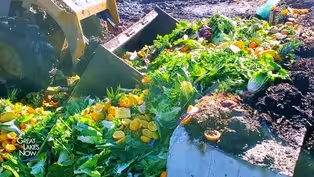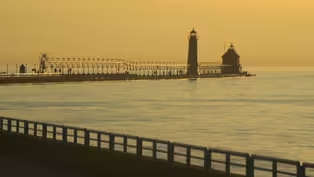
A Community Fights For A Cleaner Future
Clip: Season 3 Episode 6 | 8m 23sVideo has Closed Captions
They live in one of the most polluted areas of the Great Lakes and they’re fighting back!
The Southeast side of Chicago at the southern end of Lake Michigan was once an industrial powerhouse. Steel was the main product and thousands had good paying jobs. But, when those jobs started drying up, an industrial wasteland was left behind. After years of being surrounded by toxic waste, residents are fighting back.
Problems playing video? | Closed Captioning Feedback
Problems playing video? | Closed Captioning Feedback
Great Lakes Now is a local public television program presented by Detroit PBS

A Community Fights For A Cleaner Future
Clip: Season 3 Episode 6 | 8m 23sVideo has Closed Captions
The Southeast side of Chicago at the southern end of Lake Michigan was once an industrial powerhouse. Steel was the main product and thousands had good paying jobs. But, when those jobs started drying up, an industrial wasteland was left behind. After years of being surrounded by toxic waste, residents are fighting back.
Problems playing video? | Closed Captioning Feedback
How to Watch Great Lakes Now
Great Lakes Now is available to stream on pbs.org and the free PBS App, available on iPhone, Apple TV, Android TV, Android smartphones, Amazon Fire TV, Amazon Fire Tablet, Roku, Samsung Smart TV, and Vizio.
Providing Support for PBS.org
Learn Moreabout PBS online sponsorshipSome residents living in one of the most polluted places in the Great Lakes region are fed up for the toxic sites next to their homes and neighborhood parks.
And they're fighting for a cleaner, healthier future for their neighborhood.
- [Narrator] In its heyday, the Southeast Side of Chicago and the adjacent northwest Indiana was an industrial powerhouse and as long as jobs were plentiful residents put up with the smoky air and polluted waters of the Calumet River.
Longtime Southeast Side resident, Linda Gonzalez says all that pollution was just part of life in that area of Chicago.
- Yeah, I mean it was great.
I mean, we really weren't aware of a lot of the environmental pollutions.
You know, the steel mills were in business and there was a lot of people that were really active in the community.
- [Narrator] Decades ago it was standard practice for factories, mills and refineries to dump liquid and solid waste into nearby waterways and marshes.
But as manufacturing jobs started disappearing people were left with the ruins of industry and a polluted environment.
- [Mark] You know, this place has been a dumping ground for more than a hundred years.
- Artist Mark Banks grew up on the Southeast Side.
He works out of his garage studio - And since then we've kind of just struggled with not only the pollution itself but also the lack of any economic infrastructure.
- [Narrator] His art directly ties into his surrounding neighborhood.
- I call my art artwork, "Trespassive Art."
I go on a lot of these derelict sites to get my reference material.
For example, this painting that I'm doing right now I had to sneak onto private property on a Sunday when nobody was around to take pictures.
These are things that nobody was ever supposed to see - Living among what he describes as fields of rotting giants where steel mills once stood, Banks says he strives to transmit the violence of what he calls in industrial ecocide onto the canvas.
- And so I very much hope that my art in that spirit has some kind of ability to change people's minds and more importantly, to change policies and to change ways of being, ways of living for us (gentle upbeat music) - [Narrator] After years of putting up with industrial pollution on a grand scale Southeast Side residents are fighting back.
- I'm about a block from the Calumet River and there they used to store open piles of pet coke.
And so that stuff used to just blanket our neighborhood.
And it wasn't until some activist pushed back and really got those piles moved and covered.
- And in 2022, community activists won a victory against a scrap metal company.
In a deal worked out with City Hall years before, the company agreed to move from the north side of the city to the Southeast Side.
But residents waged a vigorous campaign against the company.
Siding with residents, City Hall eventually denied the necessary permits.
However, a judge recently ruled that the company should be allowed to operate on the Southeast Side.
Community activists say they are deeply disappointed by the ruling and will be appealing.
(electronics buzzing) - Enough is enough, no more.
We're tired of being the toxic dumping ground for the city.
- Amalia NietoGomez is Executive Director of the Alliance of the Southeast.
She says the area has more than two dozen toxic sites many of them located near schools and parks and higher rates of asthma, cancer and other chronic diseases.
- We are already environmental justice community and so we don't want any more toxic dredging here.
- [Narrator] The latest battle on the Southeast Side is over a toxic waste dump created by years of dredging the shallow Calumet River, to make it deep enough for huge freighters - This site is connected to the Illinois International Port District and its operations to allow shipping to happen.
- Juanita Irizarry is Executive Director of Friends of the Parks in Chicago.
The nonprofit group has concerns about all the muck being dredged up by the Army Corps of Engineers.
- The Calumet River is not particularly deep, and so the Army Corps needs to dredge, which ends up bringing up toxic materials that are at the bottom of the river bed.
- [Narrator] That toxic material contains lead, mercury, arsenic, barium and PCBs, just to name a few.
And it has to go somewhere.
Since the mid 1980s, it's all been dumped in what is called a Confined Disposal Facility or CDF on a little piece of land on the Southeast Side where the Calumet River meets Lake Michigan.
It is situated right next to a park called Calumet Park.
And now after decades of dredging and dumping the Army Corps of Engineers has run out of room, so it wants to expand the site, not outward but up.
- They wanna build a 25 foot higher berm and then be able to add more space behind that to keep dumping there.
We think it's ridiculous to do that in any case but most certainly right on the Lake Shore.
- [Narrator] In an effort to keep the dump from growing any larger the Environmental Law and Policy Center has filed a lawsuit on behalf of the Alliance of the Southeast and Friends of the Parks.
They are suing the US Army Corps of Engineers to force them back to the drawing board.
- They knew that this site was supposed to be closed and capped by 2022 because it would be full and they did not look at real options outside the 10th ward or outside an environmental justice community.
- The biggest worry is that the toxic materials already in the CDF could leach into Lake Michigan jeopardizing the drinking water source for millions of area residents.
- We do know that there are interactions between the lake and the retention ponds just because fish were found in the retention ponds.
So we do know there's already interaction we just don't know the extent of it, and so we would like water quality data to see what that is.
(somber music) (sea gulls calling) - The Southeast Side community activists recently scored another small victory.
The Army Corps of Engineers is delaying expansion of the CDF, after receiving a notice from the Illinois EPA.
The environmental agency said the work will now require a different type of permit than the one granted before.
The US Army Corps of Engineers declined our request for an interview.
But in a statement, a spokesperson said "Due to the new permit requirement, completion of the vertical expansion will be delayed one to two years."
A spokesperson for the Illinois EPA said various permits related to expansion of the CDF are currently under review.
The delay is good news for those fighting to stop the dump from expanding.
This gives them time to shore up support from Illinois to US Senators and newly elected Chicago Mayor Brandon Johnson.
During his recent campaign, the Mayor said he would reestablish a Department of the Environment and said he is committed to environmental justice.
- Think communities are starting to fight back and say, "Hey look, you know no more."
We've done our fair share and we need healthy alternatives now.
Battling Food Waste for People and the Planet
Video has Closed Captions
Clip: S3 Ep6 | 8m 6s | Learn how keeping food waste out of landfills can help to fight climate change. (8m 6s)
Video has Closed Captions
Clip: S3 Ep6 | 8m 13s | The Catch is Great Lakes Now’s one stop shop for bite-sized news about the lakes you love. (8m 13s)
Providing Support for PBS.org
Learn Moreabout PBS online sponsorship
- Science and Nature

Explore scientific discoveries on television's most acclaimed science documentary series.

- Science and Nature

Capturing the splendor of the natural world, from the African plains to the Antarctic ice.












Support for PBS provided by:
Great Lakes Now is a local public television program presented by Detroit PBS

